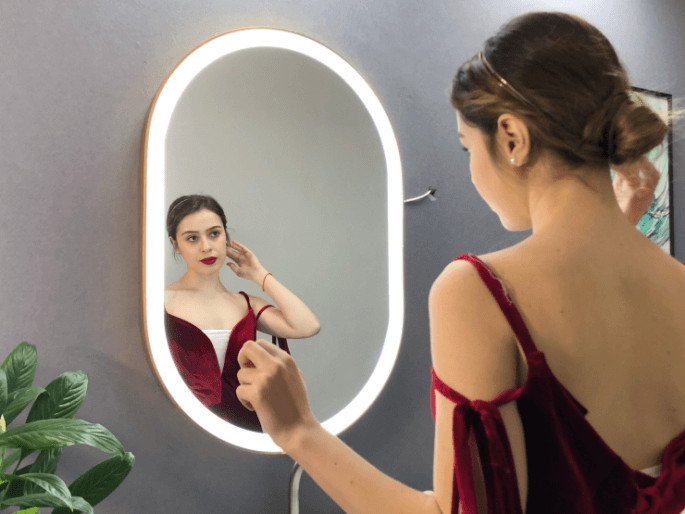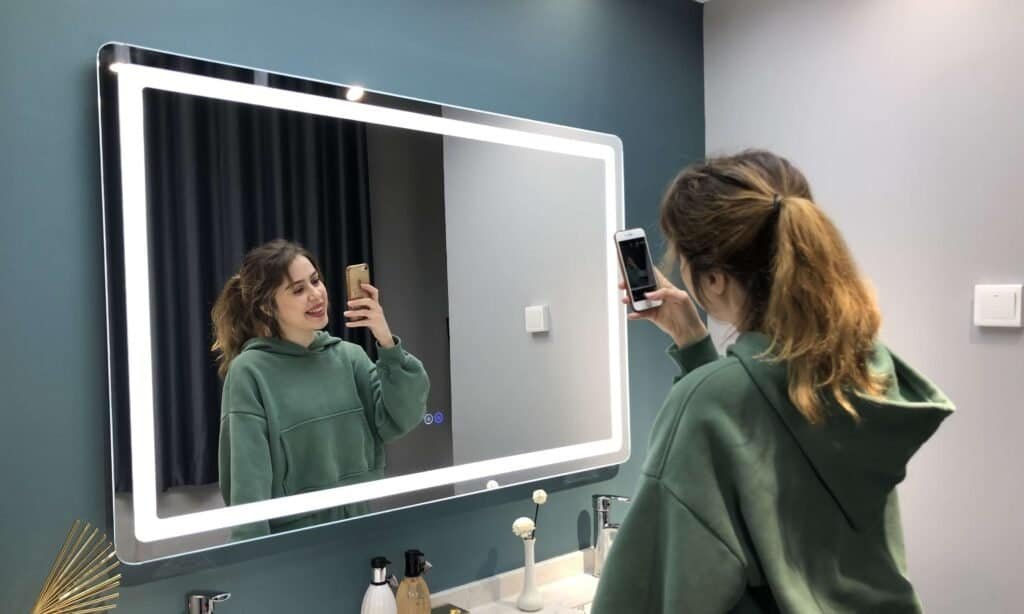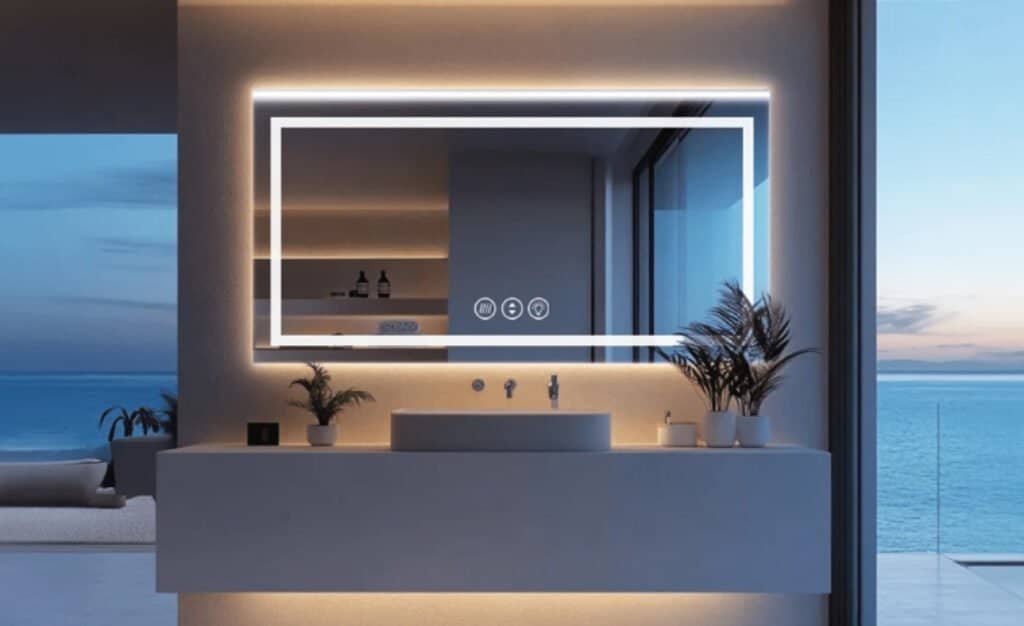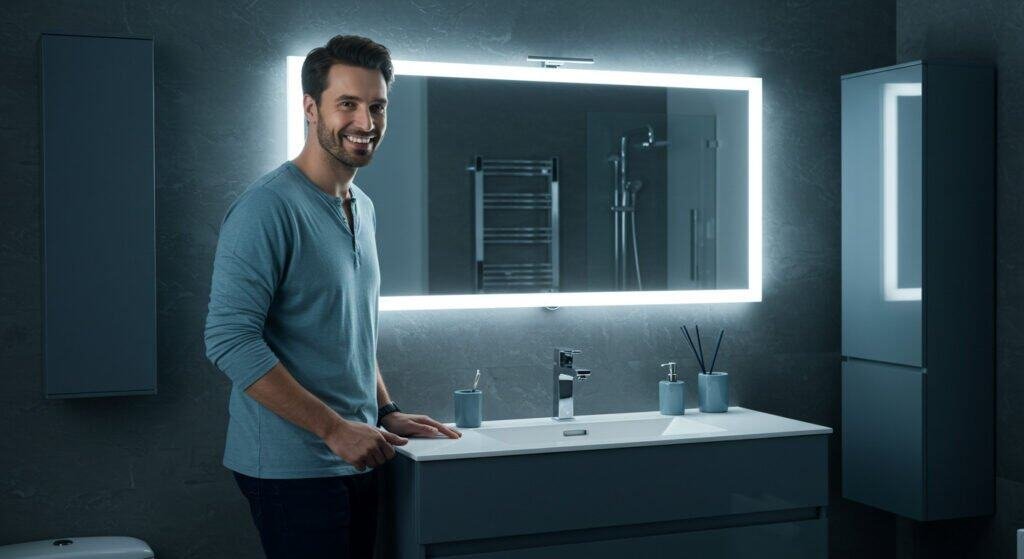How does led mirror work? Struggling with poor bathroom lighting that makes daily grooming tasks difficult? Traditional mirrors lack integrated illumination, forcing you to rely on inadequate overhead lighting.
LED mirrors work through integrated LED light strips embedded around or behind the mirror surface, powered by a low-voltage electrical system that connects to your home’s power supply. The LED lights provide even, shadow-free illumination while the mirror maintains its reflective properties through a high-quality glass surface with reflective coating.
Let’s explore the comprehensive technical details and practical applications of LED mirror technology.

What Is an LED Mirror?
An LED mirror represents a significant advancement in modern mirror technology, combining traditional reflective surfaces with integrated lighting systems. Unlike conventional mirrors that depend on external light sources, these innovative fixtures incorporate LED light strips directly into their design framework.
An LED mirror is a glass mirror equipped with built-in LED lighting elements that provide consistent, energy-efficient illumination for various applications including bathroom vanity mirrors, lighted makeup mirrors, and modern lighted mirrors for bathrooms.
With traditional mirrors, the user must rely on separate lighting fixtures to achieve the same effect. In essence, LED mirrors combine the functionality of a mirror with that of a light fixture, eliminating the need for additional lighting and creating a more streamlined and aesthetically pleasing solution.
How Does LED Mirror Work?
LED mirrors work in a simple way. Here’s how: First, strategically placed LED light strips drive and spread light evenly across the mirror’s surface.
LED mirrors function by utilizing semiconductor diodes that emit light when electrical current passes through them, while the mirror component uses a glass substrate with reflective backing to provide clear reflection combined with integrated illumination.
The technical architecture includes several critical components working in harmony. The LED strips, typically positioned around the perimeter or behind the mirror in backlit configurations, receive power through a transformer that converts standard household voltage to the low-voltage requirements of LED systems. Advanced control circuits manage dimming functions, color temperature adjustments, and timing features.
The glass mirror itself relies on high-quality silvering or aluminum backing to reflect clearly while accommodating the embedded lighting elements. Today’s LED mirrors often include other capabilities as well, such as defogging elements, touch controls and Wi-Fi connectivity options to appeal to the modern, tech-savvy consumer.

How Does Mirrors Work?
Understanding how a basic mirror works helps you appreciate the technological advances that LED mirrors offer. Traditional mirrors work on the fundamental principles of light reflection that have been around for centuries.
Mirrors work by reflecting light through a smooth, highly reflective surface, typically created by applying a thin metallic coating to the back of a glass substrate, allowing users to see their reflection based on the angle of incident light.
The science behind mirror reflection involves the law of reflection, where light rays striking the mirror surface reflect at equal angles to the incident rays. Glass mirrors achieve this through a silvering process that deposits reflective material onto the glass surface, creating a smooth, uniform reflective layer. LED integration enhances this basic functionality by providing controlled illumination that optimizes reflection quality.
The result is an even light source across the entire surface of the mirror, which eliminates shadows and uneven lighting that occur when you rely on external light sources. Some of the more advanced LED mirror designs have an anti-reflective coating on the front glass surface. This means there’s less glare, but you still get that perfect reflection that you expect from a mirror.
LED Mirror Benefits
LED mirrors provide significant advantages over traditional mirror and lighting combinations, which is why they are becoming more and more popular in residential and commercial applications. These advantages include energy efficiency, functionality and aesthetic improvements.
LED mirrors provide superior energy efficiency, enhanced lighting quality, extended lifespan, and multifunctional capabilities including defogging, color temperature control, and smart connectivity options that traditional lighting solutions cannot match.
The energy efficiency of LED technology translates to significant cost savings over the mirror’s operational lifetime. LED systems consume approximately 75% less energy than incandescent alternatives while providing superior light output and consistency. The longevity of LED components, typically rated for 25,000 to 50,000 hours of operation, reduces replacement frequency and maintenance requirements.
Modern LED mirrors offer customizable lighting experiences through adjustable color temperatures ranging from warm ambient lighting to cool task lighting, accommodating different user preferences and applications. Additional benefits include instant-on capability without warm-up periods, reduced heat generation that prevents mirror fogging, and compatibility with smart home automation systems. The sleek, contemporary appearance of LED mirrors enhances bathroom aesthetics while providing practical functionality that improves daily grooming routines.

Do All LED Mirrors Need Electricity?
The electrical specifications of LED mirrors are something that people need to understand before they buy. This question goes after misconceptions that people might have, asking for alternatives or why a claim might be misleading.
Yes, all LED mirrors require electricity to power their lighting systems, as LED technology depends on electrical current to generate light through semiconductor processes, though power requirements vary based on mirror size and feature complexity.
Typically LED mirrors work off of low-voltage systems, usually 12V or 24V DC. Working off a low-voltage system provides a lot of safety advantages, especially in a bathroom environment, as well as efficiency benefits. In terms of power consumption, it depends on the size of the mirror, the density of the LEDs and any additional features like defogging elements or smart controls. A standard bathroom vanity mirror with LED lighting might consume anywhere from 20 to 50 watts. Traditionally, incandescent vanity lights in a bathroom might consume as much as 100, 200 or 300 watts to achieve the same amount of light.
Some manufacturers offer battery-powered options for specific applications, though these are typically limited to smaller mirrors with basic functionality due to power constraints. The electrical connection can be achieved through hardwired installation or plug-in configurations, depending on local electrical codes and installation preferences. Modern LED mirrors often incorporate power management features that automatically adjust consumption based on ambient conditions or user settings, further optimizing energy efficiency.
Do LED Mirrors Have to Be Hardwired?
This question helps dispel a common misunderstanding about LED mirrors. The type of plug is a dead giveaway because it tells you it’s a low-voltage product that doesn’t require an electrician to hardwire the mirror. However, you still need to place the mirror where there’s access to a power outlet unless you plan to install a new electrical box and have wiring run inside the wall, which is a much more involved process.
LED mirrors can be installed using either hardwired connections or plug-in configurations, though hardwired installation is often preferred for permanent bathroom installations to ensure code compliance and optimal safety in wet environments.
Hardwired installation involves direct connection to the electrical system through junction boxes, typically performed by licensed electricians to ensure proper grounding and circuit protection. This method provides a clean, permanent installation without visible cords or plugs, enhancing the aesthetic appeal of lighted bathroom mirrors and modern bathroom mirrors.
The hardwired approach also enables integration with wall switches and dimmer controls for convenient operation. Alternatively, plug-in configurations offer greater installation flexibility, particularly for rental properties or temporary installations where permanent electrical modifications are not feasible.
However, plug-in installations require accessible electrical outlets and may not meet local electrical codes for bathroom installations, particularly in wet zones near water sources. Professional installation ensures compliance with electrical codes, proper GFCI protection, and optimal performance of advanced features such as defogging systems and smart controls that are common in contemporary LED mirror designs.

Comparison Table: LED Mirror Types and Features
| Mirror Type | Power Consumption | Key Features | Best Applications |
|---|---|---|---|
| Backlit Mirror | 25-40W | Edge lighting, uniform illumination | Bathroom vanity mirrors, modern bathroom mirror |
| Lighted Vanity Mirror | 30-50W | Front lighting, adjustable brightness | Makeup application, detailed grooming |
| Smart LED Mirror | 35-60W | Touch controls, Bluetooth, defogging | Tech-savvy users, luxury bathrooms |
| Rectangular Bathroom Mirrors | 20-45W | Clean lines, versatile mounting | Contemporary bathroom designs |
| Small Bathroom Mirror | 15-30W | Compact size, essential features | Space-limited installations |
What Are the Disadvantages of LED Mirrors?
For a homeowner or commercial business owner who’s considering buying an LED mirror, they need to know the potential drawbacks. People are still going to be drawn to certain features that may not outweigh the lack of other features. This question gets at those potential limitations.
LED mirror disadvantages include higher initial costs, complex installation requirements, potential repair challenges, and dependency on electrical power that may not suit all applications or user preferences.
The cost of an LED mirror, whether it’s for a residential application like a bathroom or a commercial application like a hotel room or bar, is usually higher than a traditional mirror. But a lot of times, that cost is recouped through energy savings over the life of the product. The installation can be more complicated, especially if we’re talking about hardwiring the mirror. If you’ve got to get an electrician involved and run wiring inside the wall, it’s going to be more work and more expensive.
Repairing and maintaining LED mirrors can be more complex than simply screwing in a new lightbulb that a traditional light fixture might require. If one of the electronic components goes out, you’re probably not going to repair it yourself. You’ll have to send it to a specialist who can fix it. Or you might have to replace the whole mirror. It’s not like the old days where you could stand on the counter, unscrew a lightbulb and screw a new one in.
Some people also have to get used to the way LED lighting looks. LED light has a different color-rendering index compared to incandescent light sources. Especially in a bathroom, we’re used to seeing ourselves in the mirror a certain way. The first time you look at yourself in an LED mirror, it may look a little bit different to you. It’s not a disadvantage of the mirror necessarily, but it’s something people have to get used to.
The integrated nature of LED mirrors means that electrical component failure can affect the entire unit, unlike separate mirror and lighting systems where components can be addressed independently. Additionally, the rapid evolution of LED technology may result in feature obsolescence over the mirror’s extended lifespan, though basic lighting functionality remains consistent across technology generations.

How Long Do LED Mirrors Last?
The operational lifespan of LED mirrors represents a crucial factor in evaluating their long-term value proposition compared to traditional lighting and mirror combinations. Understanding durability expectations helps consumers make informed investment decisions.
LED mirrors typically last 25,000 to 50,000 hours of operation, equivalent to 10-20 years of normal residential use, with the LED components generally outlasting other mirror elements such as electronic controls or mechanical switches.
Several factors influence LED mirror longevity, including build quality, operating environment, and usage patterns. High-quality LED chips from reputable manufacturers demonstrate superior longevity compared to lower-grade alternatives, justifying premium pricing for reliable products. Environmental conditions such as temperature extremes, humidity levels, and electrical stability affect component lifespan, with bathroom installations requiring robust designs to withstand challenging conditions.
The modular nature of LED systems allows for component replacement in some designs, extending overall mirror lifespan beyond individual component failures. Regular maintenance, including cleaning and inspection of electrical connections, helps ensure optimal performance throughout the mirror’s operational life.
Manufacturer warranties typically cover LED components for 3-5 years, reflecting confidence in the technology’s reliability. The extended lifespan of LED mirrors translates to reduced replacement costs and maintenance requirements compared to traditional lighting solutions that require frequent bulb replacements.
| Component | Expected Lifespan | Factors Affecting Longevity |
|---|---|---|
| LED Chips | 25,000-50,000 hours | Quality grade, heat management, electrical stability |
| Control Electronics | 10-15 years | Environmental conditions, usage frequency |
| Mirror Glass | 15-20+ years | Physical damage, moisture exposure |
| Power Supply | 8-12 years | Electrical load, temperature cycling |
What Are the Negative Effects of LED?
Understanding potential negative aspects of LED technology helps users make informed decisions about LED mirror adoption and implement appropriate mitigation strategies when necessary.
LED lighting can produce blue light emission that may affect sleep patterns, cause eye strain during prolonged exposure, and create color rendering differences compared to natural sunlight, though these effects are generally minimal with quality LED mirror products.
Blue light emission from LED sources has raised concerns about circadian rhythm disruption, particularly with evening exposure that may interfere with natural sleep patterns. However, LED mirrors designed for bathroom use typically incorporate warm color temperature options that minimize blue light content during evening hours.
Eye strain concerns are generally overstated for normal mirror use, as the brief exposure periods typical of grooming activities do not pose significant health risks. Color rendering index variations between LED sources and natural sunlight can affect color perception, though high-quality LED mirrors achieve CRI ratings above 90, providing accurate color representation for makeup application and general grooming tasks.
Some individuals may experience sensitivity to LED flicker, though modern LED drivers incorporate flicker-free technology that eliminates this concern. The solid-state nature of LED technology generally produces more consistent, reliable lighting compared to traditional sources, with negative effects being minimal when quality products are properly installed and used according to manufacturer guidelines.

How Does LED Mirror Work in Bathroom?
Bathroom environments present unique challenges and requirements for LED mirror operation due to moisture, temperature fluctuations, and safety considerations. Understanding bathroom-specific functionality helps users maximize the benefits of their LED mirror investment.
LED mirrors designed for bathroom use incorporate moisture-resistant construction, specialized anti-fog technology, and enhanced electrical safety features to operate reliably in humid environments while providing optimal illumination for grooming activities.
Bathroom LED mirrors must achieve appropriate IP ratings, typically IP44 or higher, to ensure safe operation in moisture-prone environments. The anti-fog functionality operates through heating elements integrated behind the mirror surface that prevent condensation formation during hot showers or baths. These defogging systems activate automatically based on humidity sensors or manual controls, maintaining clear reflection visibility in all conditions.
The lighting systems are optimized for bathroom tasks, providing shadow-free illumination that enhances visibility for shaving, makeup application, and general grooming activities. Advanced bathroom mirrors with LED lights often incorporate multiple lighting zones with independent controls, allowing users to adjust illumination based on specific tasks or time of day.
The waterproof construction extends to all electrical components, ensuring long-term reliability in challenging bathroom environments. Modern designs integrate seamlessly with contemporary bathroom aesthetics while providing practical functionality that improves daily routines.
Conclusion
LED mirrors combine advanced lighting technology with traditional reflection functionality to provide superior illumination and enhanced user experience. Their integration of energy-efficient LED systems with high-quality glass mirrors creates optimal conditions for grooming and aesthetic enhancement in modern spaces.
- Clik here to know What Is Copper Free Mirror?
- If you donot know how too choose the right bathroom height click here.
- Know more about LED bathroom mirror Problems
- Clik here to know why Touch Sensor Mirror Not Working
- Clik here to know What Are Standard Vanity Mirror Sizes?
- Clik here to know Why Are Mirrors So Expensive?
- Clik here to know Do LED Mirrors Need Electricity?
- Clik here to know Is a Lighted Mirror Enough Light for a Bathroom?
- Find out 10 Common LED Bathroom Mirror Problems Click Here



